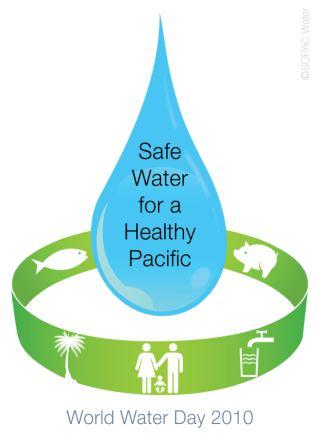Pacific Island water quality in the spotlight this World Water Day

PRESS RELEASE
FOR IMMEDIATE RELEASE
Suva, Monday 22 March, 2010: Today the world focuses its attention on water, the natural resource most vital to life. World Water Day, established by the United Nations General Assembly in 1993, is used as an opportunity to highlight critical water issues facing the planet. This year’s theme, “Clean Water for a Healthy World”, aims to raise global awareness on the importance of water quality for human health and the environment.
The impacts of recent natural disasters on water quality, outbreaks of typhoid in Fiji and Samoa, and a cholera epidemic in Papua New Guinea show that access to clean, safe water continues to be a major issue in the Pacific.
A report on sanitation, hygiene and drinking water in Pacific island countries by the World Health Organisation and the Pacific Islands Applied Geoscience Commission (SOPAC) , found that 6.7 million Pacific Islanders suffer from acute diarrhoea annually, resulting in 2800 deaths, mostly in children under five.
Pacific island countries have uniquely fragile water resources due to their small size, limited natural storage, competing land use and vulnerability to natural hazards. Urbanisation, rural development, growing populations, and increased demand from industry and agriculture is putting further pressure on the region’s freshwater resources, threatening the long term viability of communities and islands. Added to all of these issues are the increasing adverse impacts of climate change.
According to Marc Overmars, Manager of Water and Sanitation at SOPAC, pollution of freshwater resources, unsafe drinking water supplies and inadequate sanitation have a significant impact on public health, quality of life, the environment and economic development.
“While numerous aid organisations, NGOs and governments are working together on solutions to these problems, only half of the total population of Pacific island countries are served with any form of improved drinking water or sanitation,” Mr Overmars said. “There is an urgent need for measures to be put in place, which ensure people have access to clean water, and that the Pacific’s limited water resources are managed in a more integrated way.”
Good water quality also sustains healthy ecosystems, which in turn leads to improved human well-being. Healthy water systems are less prone to environmental stresses like sedimentation and flooding and provide numerous environmental services to communities.
Pilot projects that aim to manage water from “ridge to reef” are being run by International Union for the Conservation of Nature (IUCN) in Fiji and Samoa, and by SOPAC in 14 Pacific island countries through a Global Environment Facility (GEF) funded Integrated Water Resources Management project. These projects aim to put in place systems that ensure water resources are shared and sustainably managed in a way that meets the requirements of people, agriculture, industry and the environment.
Milika Sobey, Water Programme Coordinator at IUCN believes that strengthening and protecting key ecosystems is vital to ensure good water quality over the long term.
“Doing things like protecting or rehabilitating forests in catchment areas, protecting mangroves, and restoring river ecosystems increases water quality and ecosystem services in ways that benefit everyone,” Dr Sobey said. “Without these ecosystems in place, rivers are more prone to sedimentation and flooding, there is increased environmental stress, and people ultimately suffer.”
As part of this year’s World Water Day activities SOPAC and Live and Learn Environment Education, with funding from Taiwan (ROC), put together water quality awareness packs to help school children and communities better understand how they can improve water quality by protecting and managing water and water ways. These packs will be sent to all Pacific island countries.
NOTE: World Water Day in Fiji was postponed due to Hurricane Tomas and will instead be celebrated on Friday, March 26.
ENDS
Websites:
More information on World Water Day can be found here: http://www.worldwaterday2010.info/
Information on SOPAC’s water programme can be found here: http://www.pacificwater.org/
Information on IUCN’s Water programme in the Pacific can be found here: http://www.iucn.org/about/union/secretariat/offices/oceania/oro_programmes/oro_water/
Contact:
Tiy Chung, SOPAC Water Communications Advisor. Work: (+679) 338 1377 (ext 290), or mobile: (+679) 998 7586
Milika Sobey, IUCN Water Programme Coordinator. (+679) 331 9084
Notes
WHO & SOPAC (2008). Sanitation, hygiene and drinking-water in the Pacific island countries: Converting commitment into action. Manila: WHO Western Pacific Regional Office. http://www.pacificwater.org/pages.cfm/resource-center/sopac-water-publications/

















